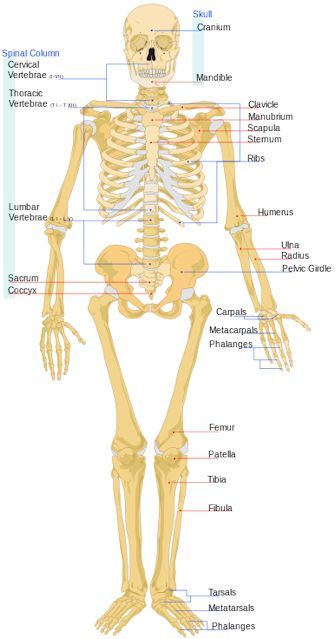Orthopedics: Bones, Joints, Ligaments and Tendons
Author: Disabled World
Updated/Revised Date: 2022/04/10
Contents: Summary - Introduction - Main - Subtopics - Publications
Synopsis: Orthopedic Information on the human musculoskeletal system including bones joints and tendons. Orthopedics is the study of the musculoskeletal system. Orthopedic doctors specialize in diagnosis and treatment of problems of the musculoskeletal system. Over the years, the field has expanded to encompass many sub-specialties and the treatment of a wide variety of musculoskeletal disorders in patients of all ages. Bones are made up of calcium, phosphorus, sodium, and other minerals, as well as the protein collagen. Calcium is needed to make bones hard, which allows them to support body weight. The soft bone marrow inside many of the bones is where most of the blood cells are made. The bone marrow contains stem cells, which produce the body's red blood cells and platelets.
Introduction
Orthopedics is the study of the musculoskeletal system. Orthopedic doctors specialize in diagnosis and treatment of problems of the musculoskeletal system. Over the years, the field has expanded to encompass many sub-specialties and the treatment of a wide variety of musculoskeletal disorders in patients of all ages.
Main Document
Orthopedic surgeons use both surgical and non-surgical means to treat musculoskeletal trauma, sports injuries, degenerative diseases, infections, tumors, and congenital conditions. The musculoskeletal system provides form, stability, and movement to the human body. It is made up of the body's bones (the skeleton), muscles, cartilage, tendons, ligaments, joints, and other connective tissue.
Continued below image.
Basic Terms
- Bursa: A small fluid-filled sac made of white fibrous tissue and lined with synovial membrane. It provides a cushion between bones and tendons or muscles around a joint
- Ligament: A small band of dense, white, fibrous elastic tissue. Ligaments connect the ends of bones together to form a joint.
- Tendon: A tough, flexible band of fibrous connective tissue that connects muscles to bones.
- Joints: Structures that connect individual bones and may allow bones to move against each other to cause movement. There are two divisions of joints, diarthroses which allow extensive mobility between two or more articular heads, and false joints or synarthroses, immovable joints, that allow little or no movement and are predominantly fibrous.
The Two Main Parts to Your Skeleton:
- The bones of your head and torso
- The bones in the arms and legs
Two Types of Bone:
- Compact bone is the solid, hard, outside part of the bone.
- Cancellous bone, which looks like a sponge, is inside the compact bone.
Five General Classifications of Bones:
- Long bones
- Short bones
- Flat bones
- Irregular bones
- Sesamoid bones
The human skeleton is composed of both fused and individual bones supported by ligaments, tendons, muscles, and cartilage.
Bones are made up of calcium, phosphorus, sodium, and other minerals, as well as the protein collagen. Calcium is needed to make bones hard, which allows them to support body weight. The soft bone marrow inside many of the bones is where most of the blood cells are made. The bone marrow contains stem cells, which produce the body's red blood cells and platelets.
Bones can move because of the way they are joined. The place where two or more bones come together is called a joint. The bones at a joint are held together by strong bands of tissue called ligaments, which allow the bones to move.
Joint Types
- A joint that permits no movement is known as a synarthrosis. The sutures of the skull and the gomphoses that connect the teeth to the skull are examples of synarthroses.
- An amphiarthrosis allows a slight amount of movement at the joint. Examples of amphiarthroses include the intervertebral disks of the spine and the pubic symphysis of the hips.
- The third functional class of joints is the freely movable diarthrosis joints. Diarthroses have the highest range of motion of any joint and include the elbow, knee, shoulder, and wrist.
Conditions that can affect the bones, muscles, and joints include:
- Osteomyelitis
- Arthritis
- Strains and sprains
- Fracture
- Osteoporosis
- Muscular dystrophy
- Osgood-Schlatter disease (OSD)
- Repetitive stress injuries
- Scoliosis
- Tendonitis
Subtopics:
Share This Information To:
𝕏.com Facebook Reddit
Page Information, Citing and Disclaimer
Disabled World is an independent disability community founded in 2004 to provide news and information to people with disabilities, seniors, their family and carers. You can connect with us on social media such as X.com and Facebook.
Cite This Page (APA): Disabled World. (2022, April 10). Orthopedics: Bones, Joints, Ligaments and Tendons. Disabled World. Retrieved May 19, 2024 from www.disabled-world.com/health/orthopedics/
Permalink: <a href="https://www.disabled-world.com/health/orthopedics/">Orthopedics: Bones, Joints, Ligaments and Tendons</a>: Orthopedic Information on the human musculoskeletal system including bones joints and tendons.
Disabled World provides general information only. Materials presented are never meant to substitute for qualified professional medical care. Any 3rd party offering or advertising does not constitute an endorsement.